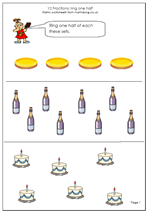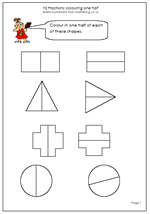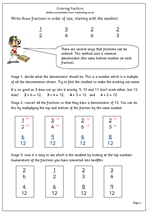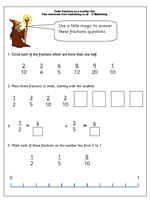 This is the second in our mini-series of fractions worksheets suitable for year 2 children, aged 5/6. The first looked at taking half of an object, in other words dividing one thing into two equal parts. This worksheet looks at a different idea of a half, that is, taking half of a number of objects. Children of this age should be beginning to know, off by heart, their doubles and halves of small numbers, and this type of work will help them.
This is the second in our mini-series of fractions worksheets suitable for year 2 children, aged 5/6. The first looked at taking half of an object, in other words dividing one thing into two equal parts. This worksheet looks at a different idea of a half, that is, taking half of a number of objects. Children of this age should be beginning to know, off by heart, their doubles and halves of small numbers, and this type of work will help them.
One way to do this is to pair off the objects, one at a time. Maybe make a small mark on them, although practical work is still the best way to do this. Another way is to count all the objects and then work out what half would be. With a small number of objects it is much easier to see instantly what half is. Again, it is important to show that there is more than one to show the answer. A good mini investigation would be to show the same 6 buttons several times and ask for different ways to ring half of them.
Tag: fractions
Y2 Maths worksheet: Fractions, recognising halves
 An important part of early fractions work is to recognise that usually there is more than one way to colour/shade/take one half of a shape. This maths worksheet, written for year 2 children, helps with recognising halves and also demonstrates with each of the four shapes that there is more than one way to divide them into two equal parts. A similar exercise can be carried out when asking children to take half of a number of objects (buttons etc). This will follow late on another worksheet.
An important part of early fractions work is to recognise that usually there is more than one way to colour/shade/take one half of a shape. This maths worksheet, written for year 2 children, helps with recognising halves and also demonstrates with each of the four shapes that there is more than one way to divide them into two equal parts. A similar exercise can be carried out when asking children to take half of a number of objects (buttons etc). This will follow late on another worksheet.
Year 6 Maths worksheet: Ordering fractions
 The big question: how do you put fractions in order of size? It is easy to compare fractions if the bottom number (the denominator) is the same for each fraction. 3/12 is smaller than 5/12 etc. But if the denominators are different it becomes more tricky.
The big question: how do you put fractions in order of size? It is easy to compare fractions if the bottom number (the denominator) is the same for each fraction. 3/12 is smaller than 5/12 etc. But if the denominators are different it becomes more tricky.
There are several ways to do this (eg treat each fraction as a division sum and use a calculator to work out the division answers and then order them) but the established method is to change each fraction so that they all have the same denominator.
Warning! If children are going to be successful with this there are several things that they already need to be confident with, including knowing tables and being able to recognise multiples of a number. They also need to know that multiplying the numerator (top) and denominator (bottom) of a fraction by the same number will not change the fractions size – equivalent fractions again! Without this knowledge they will be doomed and confused!!
Let’s take 3/4 and 2/3 as a simple example. To be able to directly compare them the denominators of both fractions need to be the same. Both fractions can be shown in twelfths. (If you don’t understand why I have chosen twelfths then have a look at some of the equivalent fraction pages on the site.)
3/4 can be changed by multiplying 4 by 3 and then 3 by 3 to give 9/12.
2/3 can be changed by multiplying 3 by 4 and 2 by 4 to give 8/12
From this it can be sen that 2/3 or 8/12 is smaller than 3/4 or 9/12.
There is a more detailed explanation on ordering fractions on the maths worksheet pages.
Year 5 maths worksheet: equivalent fractions
 Understanding equivalence in fractions is the key to successfully understanding fractions.
Understanding equivalence in fractions is the key to successfully understanding fractions.
This maths worksheet looks at simple equivalence between halves, fifths, tenths etc. The first question asks which fractions are more than a half. The quick way to work this out is to see if the top number (numerator) is more than double the bottom number (denominator) – if it is then it is more than one half.
The second question requires an understanding that a fraction such as three fifths can be changed to an equivalent fraction such as six tenths by multiplying both the numerator and denominator by the same number (in this case 2, but it willl not always be 2).